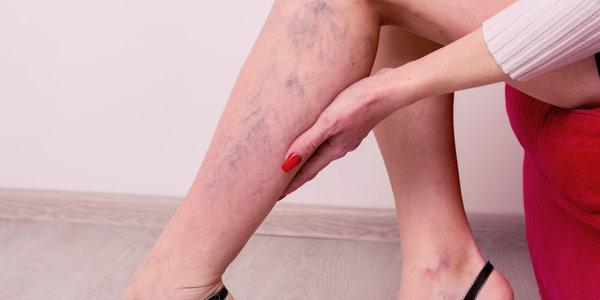
Varicose Vein Treatment
Varicose veins can be a nuisance, and the symptoms are not just cosmetic. Yes, the thin dark veins aren’t attractive, but the aching, cramping, and swelling can affect your everyday routine and keep you from living the life you want.
Sometimes no matter how much you try to prevent bulging veins; they’ll sprout up somewhere on you anyway. Unfortunately, for many, varicose-free legs are more a dream than a reality. In fact, it’s estimated that nearly 40 million people in the USA suffer from varicose veins, and only 1% every seek treatment.
Luckily, there are new technologies to treat and eliminate varicose veins and symptoms of venous insufficiency.
When they appear, varicose veins can make you self-conscious and impact your quality of life. It’s essential to understand precisely what varicose veins are, how they differ from spider veins and common reasons you may see either develop.
Varicose Veins vs. Spider Veins
Varicose veins are large, swollen, protruding blood vessels that twist and turn beneath the surface of your skin. Because they’re raised and large, they’re clearly visible. They will often cause swelling making your legs feel heavy or uncomfortable. They can also lead to more severe health conditions, like blood clots and leg ulcers.
Several patients who suffer from varicose veins often complain of a cramping or aching sensation near the veins. Other typical symptoms include fatigue, itching, throbbing, cramping, burning, and tingling.
Varicose veins, however, shouldn’t be confused with spider veins. Spider veins are the much earlier, gentler version of varicose veins. They’re best described as tiny, blue, red, or purple vessels near the surface of the skin. Like varicose veins, spider veins also twist and turn, but they don’t bulge or swell. Generally, spider veins aren’t painful, and they are not associated with blood clots.
Both spider and varicose veins indicate the presence of underlying vein disease, also known as chronic venous insufficiency.
How Varicose and Spider Veins Develop
Varicose and spider veins develop naturally when blood flow issues are present. A healthy vein will carry blood to the heart through valves that allow blood to flow in only one direction keeping the blood moving through the right pathways and preventing backflow. These healthy veins do their job by effectively delivering blood from superficial veins to deeper ones that eventually lead to the heart.
However, when veins don’t function properly, it can cause blood to collect inside your veins. When this happens, the blood pushes up against the walls within your vein, creating pressure weakening the vessel wall. Ultimately, this pressure is what causes veins to twist and bulge.
Depending on how large the vein is and how swollen it gets, it will result in spider veins or varicose veins.
Risk Factors
Unfortunately, there aren’t just one or two factors that can influence the likelihood of developing spider or varicose veins—there are several.
Heredity: People with a family history of vein disease have a higher risk of having it themselves.
Gender: Women are almost twice as likely to have varicose veins than men. Studies show that 17% of men and 33% of women are diagnosed with varicose veins.
Weight: The more you weigh, the more pressure you’re putting on your legs and the more likely you are to develop varicose veins.
Hormonal imbalances: Factors multiple pregnancies and menopause can affect your hormone levels, which can trigger the development of vein disease. Estrogen hormone treatment can also increase your risk.
Occupation: People who have jobs that require them to stand long periods are more likely to develop problematic veins.
Smoking: Smoking is detrimental to your health and body, including your veins, because it causes damage to your blood vessels, increasing your chances of vein disease.
Treatment Options for Vein Disease
If you’re eager to rid your legs of varicose and spider veins and regain your quality of life, there are several proven medical treatments for you to consider.
Polidocanol Injectable Foam (Varithena®) is a minimally invasive, nonsurgical treatment doesn’t require incisions. The injection site is usually numbed, but no additional anesthesia is required. A catheter is inserted into the malfunctioning vein or sometimes a direct injection is used. The foam fills up the targeted part of the vein, and the diseased vein collapses. (For smaller branches with vein reflux, foam is injected directly into the vein to eliminate it.) Blood flow shifts to healthier veins nearby.
The VenaSeal™ Closure System uses an advanced medical adhesive to close and seal varicose veins. VenaSeal™ treatment minimizes patient discomfort and reduces recovery time, making it a good choice for many people. It’s the only procedure approved for use in the United States that doesn’t use heat, tumescent local anesthesia, or a sclerosant. Instead, VenaSeal™ uses a medical grade “glue” to shut down diseased veins.
Thermal Ablation, with this procedure, a small catheter is placed into the problematic vein, usually longer and larger veins. This catheter delivers radiofrequency into the vein wall, causing it to grow hot, collapse and close. It is an outpatient procedure that requires the administration of local anesthesia.
Ultimately, remember that vein disease is progressive and will get worse without treatment, so when you see signs of it, seek treatment.